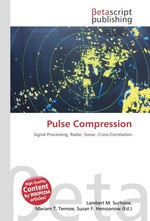Pulse Compression
Lambert M. Surhone, Mariam T. Tennoe, Susan F. Henssonow
бумажная книга
Please note that the content of this book primarily consists of articles available from Wikipedia or other free sources online. Pulse compression is a signal processing technique mainly used in radar, sonar and echography to augment the range resolution as well as the signal to noise ratio. This is achieved by modulating the transmitted pulse and then correlating the received signal with the transmitted pulse. The simplest signal a pulse radar can transmit is a sinusoidal pulse of amplitude, scriptstyle A and carrier frequency, scriptstyle f_0, truncated by a rectangular function of width, scriptstyle T. Let us determine the range resolution which can be obtained with such a signal. The return signal, written scriptstyle r(t), is an attenuated and time-shifted copy of the original transmitted signal (in reality, Doppler effect can play a role too, but this is not important here.) There is also noise in the incoming signal, both on the imaginary and the real channel, which we will assume to be white and Gaussian (this generally holds in reality); we write scriptstyle B(t) to denote that noise.
Данное издание не является оригинальным. Книга печатается по технологии принт-он-деманд после получения заказа.


